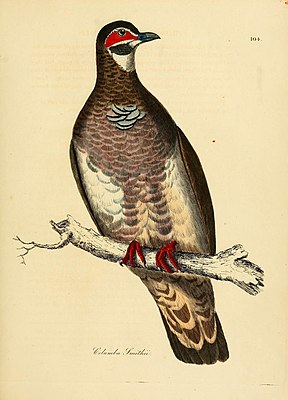Red-capped pigeon
| Red-capped pigeon | ||||||||||
|---|---|---|---|---|---|---|---|---|---|---|

Red-capped pigeon ( Geophaps smithii ) |
||||||||||
| Systematics | ||||||||||
|
||||||||||
| Scientific name | ||||||||||
| Geophaps smithii | ||||||||||
| ( Jardine & Selby , 1830) |
The red-rimmed pigeon ( Geophaps smithii ), also called scallop -breasted pigeon , naked-eye pigeon or Smith pigeon , is a species of pigeon birds. The species occurs in two subspecies exclusively in Australia. The species is classified as near threatened by the IUCN . The reason for this classification is the relatively small population size and the assumption that the population of this species is continuously decreasing.
Appearance
The red-rimmed pigeon reaches a body length of 28 centimeters. It is about the size of a city pigeon. It is very similar to the letter dove , which is also included in the genus Geophaps .
The plumage of the red-rilled pigeon is predominantly dull brown. There are clear white spots on the head. A large, unfledged red eye ring runs around the eye. It is narrowly lined and has led to the name red-rimmed pigeon. The red-rimmed pigeon has a light, blue-gray spot on the center of the chest, which appears to be scaly black due to the fringing of the feathers. The lower breast is tinged with dull brown and wine pink. The flanks are white. The iris is bright. The feet and legs are red.
Distribution area
The red-capped pigeon is found exclusively in the north and west of Australia. She lives in open grasslands that are interspersed with trees. The IUCN estimates the population at 20,000 birds. The distribution area covers almost 40,000 square kilometers.
The original range has shrunk within the last century. In the west, east and south of the original area, the red-eyed pigeons have now disappeared. Today it only settles about half of its original range.
behavior
The red-capped pigeon inhabits grasslands that are interspersed with trees. She is a species that is highly adapted to life on the ground. During the day she stays in small groups on the floor. Unlike the closely related Spinifex pigeon, however, it rears up when it feels threatened. Their diet consists mainly of grass and acacia seeds. The breeding season falls in the dry season. Most clutches are laid between March and October. The nest is on the ground and is a flat hollow with a few stalks and leaves. The clutch consists of two eggs.
According to the IUCN , the red- capped pigeon may benefit from the spread of the Aga toad introduced in Australia : monitor lizards are major predators of the red-capped pigeon. However, their numbers are falling because they poison themselves from eating cane toads.
supporting documents
Individual evidence
- ↑ Rösler, p. 171
literature
- Gerhard Rösler: The wild pigeons of the earth - free living, keeping and breeding. Verlag M. & H. Schaper, Alfeld Hannover 1996, ISBN 3-7944-0184-0 .
Web links
- Birdlife factsheet on the red-eyed pigeon , accessed on May 23, 2009
- Geophaps smithii inthe IUCN 2013 Red List of Threatened Species . Listed by: BirdLife International, 2012. Retrieved October 31, 2013.